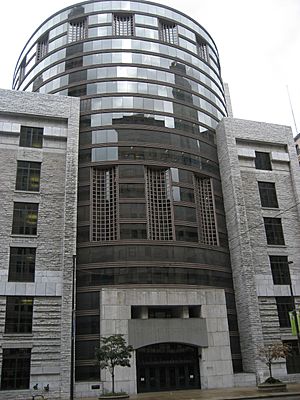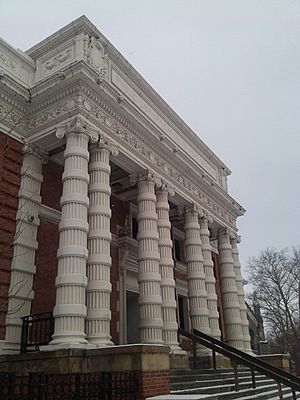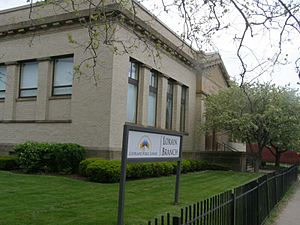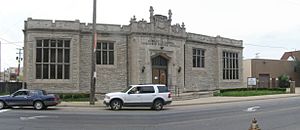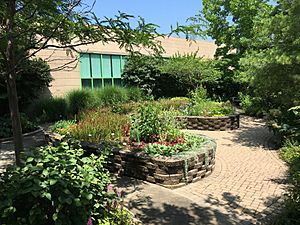Cleveland Public Library facts for kids
Cleveland Public Library is a super cool place in downtown Cleveland, Ohio! It's not just one building; it has a main library, 27 smaller branches all over the city, a mobile library that travels around, and even a special library inside City Hall. There's also a special library for people who are blind or have physical disabilities. Since 2003, it's also been the home for the Ohio Center for the Book.
Quick facts for kids Cleveland Public Library |
|
|---|---|
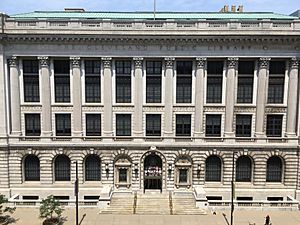 |
|
| Front entrance to the Cleveland Public Library Main Library on Superior Avenue | |
| Country | USA |
| Established | 1869 |
| Location | 325 & 525 Superior Avenue Cleveland, Ohio 44114 |
| Branches | Main Library and 27 branch libraries |
| Collection | |
| Size | 10,557,336 (2016) |
| Legal deposit | Selective federal depository library |
| Access and use | |
| Circulation | 5.5 million (2016) |
| Other information | |
| Director | Felton Thomas, Jr. (2009) |
Contents
History of the Library
How the Library Started
The idea for the Cleveland Public Library began way back in 1811. Sixteen of Cleveland's first residents started a small library. They wanted to share rare books with each other. They read books like the history of Rome and Don Quixote.
In 1867, school boards from Cleveland and other Ohio cities asked the state government for help. They wanted to collect a small tax to pay for free public libraries. This new law allowed cities with over 20,000 people to collect money for libraries. The Cleveland school superintendent, Reverend Anson Smyth, supported this idea.
The new law made the Cleveland library part of the school system. It was controlled by the Cleveland Board of Education for its first ten years.
The Cleveland Public Library officially opened on February 17, 1869. It was on the third floor of a building on West Superior Avenue. The library started with about 5,800 books.
Early Librarians and New Ideas
Luther Melville Oviatt was the first librarian, from 1869 to 1875. In his first year, people borrowed 65,000 books! He wanted books for everyone: kids, adults, workers, and scholars. He even had "open shelves." This meant people could look at books themselves, which was a new idea then.
Librarian William Howard Brett opened the library's first special room just for children. This happened on February 22, 1898. Effie Louise Power became Cleveland's first children's librarian.
In 1915, the firm of Walker and Weeks won a contest to design a new library building. Construction started in 1923, after World War I. Linda Anne Eastman led this project. She was the first woman to lead a major U.S. city library system. She also believed in open shelves, letting people browse for books.
Main Library Buildings
The Main Library has two large buildings. The older building was finished on May 6, 1925. It has five floors, each as tall as two regular floors! It was updated between 1997 and 1999. During this update, a huge mural called "Dominance of the City" was restored. Ora Coltman painted this mural in 1934.
In 1957, the library bought another building nearby. This building was later torn down in 1994. A new building was built in its place. This second building is named after former U.S. Representative Louis Stokes. It opened on April 12, 1997. Louis Stokes said it was "the most beautiful" library he had ever seen. This building cost $65 million. It held eight million items when it opened.
The two main library buildings are connected by an underground hallway. This hallway goes under the beautiful Eastman Reading Garden. This garden has cool sculptures by Maya Lin and Tom Otterness.
Special Collections to Explore
The library has a Special Collections Department. This department was started thanks to John G. White. He was a library board president for many years. He gave and bought many rare books for the library. He also helped build the special reading room for these collections.
Some cool things you can find in the Special Collections include:
- The John G. White Chess and Checkers Collections: A huge collection of books about chess and checkers.
- The John G. White Collection of Folklore and Orientalia: Books about myths, legends, and cultures from around the world.
- The John F. Puskas Miniature Books Collection: Tiny books, some as small as a postage stamp!
- The Tobacco Collection: Books about the history of tobacco.
- The Anisfield-Wolf Book Awards: Books that have won awards for dealing with racism and diversity.
Neighborhood Branches
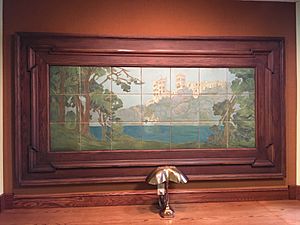
In the 1890s, William Howard Brett opened four smaller branch libraries. He kept asking Andrew Carnegie, a very rich businessman, for money to build permanent libraries. For 12 years, Carnegie said no. But Brett kept trying!
Finally, in 1903, Carnegie gave $250,000 to build seven branches. He was so impressed with how Brett managed the money that he gave even more! In total, Carnegie gave $507,000, which built 15 branches. These became the start of one of the biggest library branch systems in the U.S.
Some children in poorer neighborhoods couldn't get to the main library or the new branches. So, William Howard Brett and Miss Eastman started "home libraries." They put small collections of books in neighborhood homes. By 1913, there were 57 home libraries serving families from many different countries.
Today, the Cleveland Public Library has 27 neighborhood branches. These are located all over the city. There's also the Ohio Library for the Blind and Physically Disabled.
- Addison Branch
- Brooklyn Branch
- Carnegie-West Branch - the biggest neighborhood branch
- Collinwood Branch
- East 131st Street Branch
- Eastman Branch
- Fleet Branch
- Fulton Branch
- Garden Valley Branch
- Glenville Branch
- Harvard-Lee Branch
- Hough Branch
- Jefferson Branch
- Langston Hughes Branch
- Lorain Branch
- Martin Luther King, Jr. Branch
- Memorial-Nottingham Branch - also home to the Ohio Library for the Blind and Physically Disabled
- Mount Pleasant Branch
- Public Administration Library
- Rice Branch
- Rockport Branch
- South Branch
- South Brooklyn Branch
- Sterling Branch
- Union Branch
- Walz Branch
- West Park Branch
- Woodland Branch
Next to the Ohio Library for the Blind and Physically Disabled is a special Sensory Garden. This garden was started in 1998. It has plants chosen for their interesting textures and unique smells.
Branch Revitalization Project
In 2019, the library announced a big plan to update all 27 branches. This project will cost $100 million over ten years. It started with a $4.1 million renovation of the South Branch. This transformed the old 1911 building into a bright, beautiful space. After all the branches are updated, the Main Library downtown will get a $65 million renovation.
Cool Art and Architecture
The library has some amazing art! In 1933, the Public Works of Art Project brought artists to Cleveland. Linda Eastman believed that art could help people discover books. She also thought art could teach and inspire on its own.
Some famous murals in the library include "The City in 1833" by William Sommer. There's also "Early Transportation" by Donald Bayard. And, of course, Ora Coltman's "The Dominance of the City."
Later, more artists painted new murals for Brett Hall. These include "Sommer's Sun" by Edwin Mieczkowski, "Night Sky" by Christopher Pekoc, and "Public Square" by Robert Jergens.
In the Main Library entrance hall, there's a huge, pearl-gray art glass globe hanging. It was made in 1925. This globe is based on a map by Leonardo da Vinci. That map is one of the oldest to show the Americas!
You can also see portraits of important people like Louis Stokes and Stephanie Tubbs Jones at the library. These were painted by artist Khaz Ra'el.
Recent Library News
In 2016, the Cleveland Public Library had over 10.5 million items in its collection! It's part of CLEVNET, which is a group of 44 public libraries in northern Ohio. This means library users can borrow items from all these libraries. Since 1947, it's also been a special library for the United Nations. It holds UN documents for the state of Ohio.
In 2002, the library started letting people download digital books and magazines. This was through a new e-book system. This made it easier for people to read books on their computers.
In 2012, the library made a plan for the future. It focused on helping communities learn. It also prepared for its 150th anniversary in 2019.
The library launched "Tech Central" on June 14, 2012. This cool space has 90 computers and tables for group work. It even has a 3D printer!
Cleveland Public Library also opened a "digitization hub" in 2015. It's called the Cleveland Digital Public Library. This hub helps turn old historical items into digital files. This way, more people can see and learn from them online.
In 2018, the library was recognized for its digital work. It digitized a huge report about the First United States Army in World War II.
The Cleveland Public Library celebrated its 150th anniversary in 2019! They had a street festival, a puppet show, and events with authors. Local photographers and storytellers also shared their work about Cleveland.
Famous People Who Worked Here
Many important people have worked at the Cleveland Public Library:
- William Howard Brett - Head Librarian from 1884 to 1918. He was one of the most important librarians of his time.
- Marilla Waite Freeman - Head Librarian of the Main Library from 1922-1940. She was a well-known librarian and author.
- Lawrence Quincy Mumford - He was a Cleveland Public Library Director. He later became the Librarian of Congress for the entire United States!
- Andre Norton - A librarian who became a famous science fiction and fantasy author. She wrote the Witch World series.
- Effie Louise Power - A pioneer in library services for children and young people.
- John Griswold White - A library board member and president. He was also a famous chess historian.


